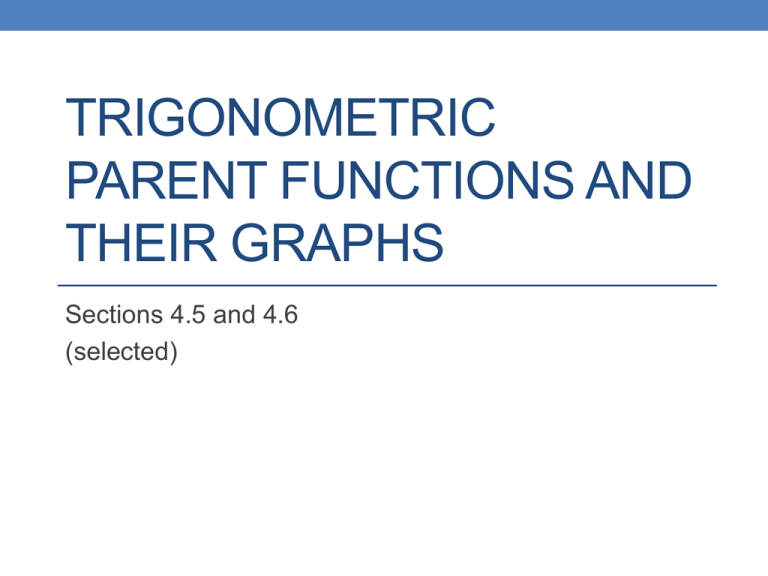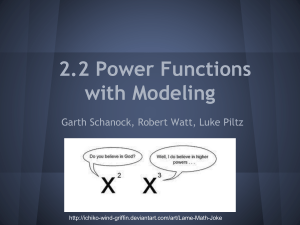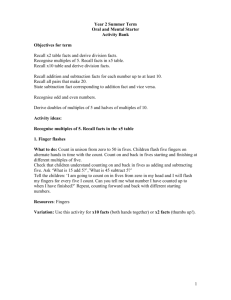Trigonometric Parent Functions and their Graphs
advertisement

TRIGONOMETRIC PARENT FUNCTIONS AND THEIR GRAPHS Sections 4.5 and 4.6 (selected) THINK?????? • Give an example of a behavior that repeats a particular pattern over and over. Seasons & Daylight Hours • High & Low Tides • Heartbeats • Sleep Patterns • Motion of a Spring as it goes to equilibrium • Yearly Temperatures at a particular location • Swing of a Pendulum http://mw.concord.org/modeler1.3/mirror/mechanics/pendulum.gif “Periodic” • Behavior that repeats a pattern infinitely • Period is the time it takes to complete one full cycle • Example: The ocean level at a beach varies from low tide to high tide and then back to low tide approximately every 12 hours. • Trigonometric functions are used to model periodic phenomena. • Why? By starting at point P(x, y) on the unit circle and traveling a distance of 2p units, 4p units, 6p units, and so on, we return to the starting point P(x, y). Because the trigonometric functions are defined in terms of the coordinates of that P, if we add (or subtract) multiples of 2p to t, the values of the trigonometric functions of t do no change. http://www.xpmath.com/careers/topic sresult.php?subjectID=4&topicID=14 Careers that use trigonometric functions RECALL • In a unit circle, the radian measure of the central angle is equal to the length of the intercepted arc, both of which are given by the same real number t. • For each real number t, there corresponds a point P(x, y) on the unit circle. • In terms of a function, the input is the real number t and the output involves the point P(x, y) on the unit circle that corresponds to t. INTRODUCTION • Trigonometric Functions (aka Circular Functions) can be graphed in a rectangular coordinate system by plotting points whose coordinates satisfy the function • We will use the traditional symbol, x, to represent the independent variable, measured in radians and y or f(x) to represent the dependent variable • http://demonstrations.wolfram.com/SineCos ineTangentAndTheUnitCircle/ Characteristics of y = sin(x) • Function, passes vertical line test • Domain: D (-∞, ∞) • Range: R [-1, 1] • Is periodic (pattern repeats). The period is 2π • Is odd (symmetric to origin) • Zeros occur at (0,0) (π, 0) (2π, 0) • Relative minimums • Relative maximums • Y-intercept is (0,0) 3𝜋 occurs at ( , -1) 2 𝜋 occur at ( , 1) 2 Real-World Applications • Sound Waves (Music, Radio, TV, etc.) Real-World Applications • Yearly Temperature at Central Park (or any specified location Characteristics of y = cos x • Function, passes vertical line test • Domain: D (-∞, ∞) • Range: R [-1, 1] • Is periodic (pattern repeats). The period is 2π • Is even (symmetric to y-axis ) • Zeros occur at 𝜋 ( , 2 0) and 3𝜋 ( , 2 0) • Relative minimums occurs at (π, -1) • Relative maximums occur at (0, 1) and (2π, 1) • Y-intercept is (0,1) Real World Applications • Brain Waves Real World Applications • Tides Characteristics of y = tan x • Function, passes vertical line test • Domain: D-all real numbers except odd multiples of • Range: R (-∞, ∞) • Is periodic (pattern repeats). The period is π • Is odd (symmetric to origin ) • Zeros occur at (0,0) (π, 0) • No Relative minimums • No Relative maximums • Y-intercept is (0,0) • Vertical asymptotes occur at odd multiples of 𝜋 2 𝜋 2 Real World Applications • http://catcode.com/trig/trig13.html Characteristics of y = csc x • Function, passes vertical line test • Domain: D –all real numbers except integral multiples of π • Range: R (-∞,-1] U [1, ∞) • Is periodic (pattern repeats). The period is 2π • Is odd (symmetric to origin ) • No Zeros • No Y-intercept • Vertical asymptotes occur at integral multiples of π Characteristics of y = sec x • Function, passes vertical line test • Domain: D- all real numbers except odd multiples of • Range: R (-∞,-1] U [1, ∞) • Is periodic (pattern repeats). The period is 2π • Is even (symmetric to y-axis ) • No Zeros • Y-intercept is (0,1) • Vertical asymptotes occur at odd multiples of 𝜋 2 𝜋 2 Characteristics of y = cot x • Function, passes vertical line test • Domain: D- all real numbers except integral multiples of π • Range: R (-∞, ∞) • Is periodic (pattern repeats). The period is π • Is odd (symmetric to origin ) • Zeros occur at 𝜋 ( , 2 0) 3𝜋 ( 2 ,0) • No relative minimums/maximums • No Y-intercept • Vertical asymptotes occur at integral multiples of π • http://www.youtube.com/watch?v=RmYv0xsz31k










